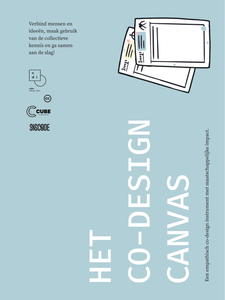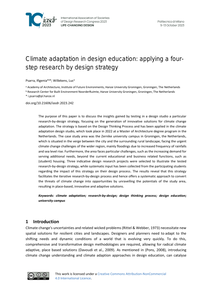Dariah was een Erasmus+ project omtrent Design Thinking in Arts and Sciences. Dariahteach bevat een aantal open online leermaterialen, gericht op docenten en studenten in Digital arts & humanities, maar is veel breder bruikbaar. Het is ontwikkeld voor zelfstudie, vooral voor diegene die geen toegang hebben tot specifieke trainingen in hun opleidingen, zaols design thinking. Het geeft veel achtergronden rondom makerscultuur, en concrete online cursusses met filmpjs, voorbeelden en toetsvraegn. De introductie module geeft een overzicht wat design thinking is en de module ‘how to practice design thinking’, ontwikkeld doro Guido Stompff, is vooral gericht op de praktijk en is ingeschaald als 5EC.
LINK
Game-based learning (GBL) and gamification can improve the learning experience of students by making learning more fun, interesting, and motivating. However, integrating games in practice is challenging for many teachers as it requires competences that not necessarily are part of their teaching repertoire. Game-based pedagogy (GBP) refers to the teaching methods and learning processes involved in learning with games. Research stresses the need for adequate professional development and teacher education on GBP. However, there is a lack of empirical knowledge on effective methods to prepare pre-service and in-service teachers for using game-based learning. The aim of our research is to gain insight into the design of effective GBP learning experiences for teachers. The guiding research question was: What design elements of a course on GBL impacted in-service teachers' GBP competences and teaching practice? We investigated this question in the context of a teacher education program in the Fall 2023. We conducted an empirical study in which a course on GBL was designed, implemented, and evaluated in practice. The participants were 16 in-service secondary teachers from different disciplines in secondary education, from which 13 agreed to participate in this study, and three course leaders. We investigated participants’ and course leaders’ experiences, participants’ competences in GBP, the impact on participants’ teaching practice and the way design elements contributed to it. The data consisted of participant reflections, transcripts from participants and course leaders’ interviews and answers to a questionnaire. The data was collected and analysed using quantitative and qualitative methods between January and April 2024. Results reveal that in-service teachers’ improved their competences on GBP and increased their use of GBL in practice. Qualitative data analysis provides insight into the course's design elements and on participants’ learning process. This study contributes to GBP-education by offering a possible design solution and framework for developing effective teacher education.
DOCUMENT

Teacher development courses should be based on both research and literature to promote their success and impact in practice. In this article, we translate the findings of research studies and theories into evidence-based design principles for a professional development course for honors teachers. This course was evaluated on the level of teacher reaction, teacher learning, outcomes, and organizational response. Nine design principles were formulated and translated into concrete actions, resulting in a one-year course (study load of 140 hours), ‘A Teacher’s Road to Excellence.’ We evaluated the impact of the course with a questionnaire filled in by participants (N=10) who finished the course one year ago. The design principles showed to be helpful in developing this course for honors teachers. The course, ‘A Teacher’s Road to Excellence,’ seems to be instructive for honors teachers and impact on student learning outcomes is seen. More research is needed to improve its impact further, on organizational level.
DOCUMENT

In this paper we explore the influence of the physical and social environment (the design space) son the formation of shared understanding in multidisciplinary design teams. We concentrate on the creative design meeting as a microenvironment for studying processes of design communication. Our applied research context entails the design of mixed physical–digital interactive systems supporting design meetings. Informed by theories of embodiment that have recently gained interest in cognitive science, we focus on the role of interactive “traces,” representational artifacts both created and used by participants as scaffolds for creating shared understanding. Our research through design approach resulted in two prototypes that form two concrete proposals of how the environment may scaffold shared understanding in design meetings. In several user studies we observed users working with our systems in natural contexts. Our analysis reveals how an ensemble of ongoing social as well as physical interactions, scaffolded by the interactive environment, grounds the formation of shared understanding in teams. We discuss implications for designing collaborative tools and for design communication theory in general.
MULTIFILE

Whereas blended learning can deliver several benefits to students in highereducation, their achievement depends on how exactly it is designed. A participatorydesign is recommendable to try to meet the needs of all stakeholders. ThePersuasive System Design-model can be used to motivate students during theonline part of the course. In the design there has to be an optimal blend betweenthe different parts of the course. A participatory design is used to design ablended learning course of autobiographical reflection for second year socialwork students. The blended course was developed in six meetings with aworking group, including all stakeholders (students, teachers, instructional designers,educational experts and professionals). Almost all techniques of the firstthree categories of the PSD-model were used in the design of the blended course.None of the techniques of the fourth category ‘Social Support’ of the PSD-modelwere used, mostly because they touch on the personal process of autobiographicalreflection. It was considered helpful for teachers to have a protocol thatassists them in blending the different parts and this in turn could stimulatestudents to be engaged in the different parts of the blended learning course. Inthis study, we found that the participatory design approach may lead to anengaging blended learning course that encourages the use of persuasive technologywith an optimal focus on content, target group, context and ethical aspectsof the blended course. We suggest adding a new fifth category ‘Blended LearningSupport’.What do you want to do ?New mail
MULTIFILE

Het Co-Design Canvas is een instrument om samenwerkingen rondom maatschappelijke uitdagingen met verschillende betrokkenen open en transparant te starten, plannen, uitvoeren en evalueren. Het biedt een hulpmiddel aan overheden, burgers, bedrijven, non-profitorganisaties, kennisinstellingen en andere belanghebbenden om helder te kunnen communiceren en samenwerken. Het maakt verschillen in belangen, kennis, ervaring en machtsverhoudingen inzichtelijk, staat vanaf het begin stil bij gewenste positieve impact en concrete resultaten en zorgt ervoor dat ieders stem echt gehoord wordt.
MULTIFILE

This investigation explores relations between 1) a theory of human cognition, called Embodied Cognition, 2) the design of interactive systems and 3) the practice of ‘creative group meetings’ (of which the so-called ‘brainstorm’ is perhaps the best-known example). The investigation is one of Research-through-Design (Overbeeke et al., 2006). This means that, together with students and external stakeholders, I designed two interactive prototypes. Both systems contain a ‘mix’ of both physical and digital forms. Both are designed to be tools in creative meeting sessions, or brainstorms. The tools are meant to form a natural, element in the physical meeting space. The function of these devices is to support the formation of shared insight: that is, the tools should support the process by which participants together, during the activity, get a better grip on the design challenge that they are faced with. Over a series of iterations I reflected on the design process and outcome, and investigated how users interacted with the prototypes.
DOCUMENT

This paper discusses two studies - the one in a business context, the other in a university context - carried out with expert educational designers. The studies aimed to determine the priorities experts claim to employ when designing competence-based learning environments. Designers in both contexts agree almost completely on principles they feel are important. Both groups emphasized that one should start a design enterprise from the needs of the learners, instead of the content structure of the learning domain. However, unlike business designers, university designers find it extremely important to consider alternative solutions during the whole design process. University designers also say that they focus more on project plan and desired characteristics of the instructional blueprint whereas business designers report being more client-oriented, stressing the importance of "buying in" the client early in the process.
DOCUMENT

Dames en heren, het is mij een grote eer dat u met zo velen gekomen bent om te luisteren naar mijn openbare les in het kader van mijn benoeming tot lector product design & engineering. Ik begrijp best dat u gekomen bent, want product design & engineering is belangrijk. Zonder product design & engineering was u hier tenslotte niet eens geweest. De auto, trein of bus waarmee u hier gekomen bent, zijn mede tot stand gekomen dankzij product design & engineering. Dat u mij ook achter in de zaal kunt horen, heeft u te danken aan ditzelfde vakgebied. En dat u aan het eind van deze openbare les mogelijk pijn in uw rug heeft door een oncomfortabele zit is er ook een gevolg van. Kortom: product design & engineering is een belangrijk vakgebied waarmee we in ons dagelijks bestaan voortdurend geconfronteerd worden, aangenaam of niet. Mijn voordracht valt in drieën uiteen. Eerst sta ik stil bij de titel: Van vuistbijl tot mobieltje. Aan de hand van deze objecten illustreer ik de historische achtergronden van het vakgebied product design & engineering. Daarna ga ik dieper in op het begrip ontwerpen. Het derde deel van mijn openbare les gaat over de ambitieuze plannen van de kenniskring product design & engineering. Ik sluit mijn openbare les af met het mobieltje, maar hoe blijft nog even een verrassing.
DOCUMENT

The purpose of this paper is to discuss the insights gained by testing in a design studio a particular research-by-design strategy, focusing on the generation of innovative solutions for climate change adaptation. The strategy is based on the Design Thinking Process and has been applied in the climate adaptation design studio, which took place in 2022 at a Master of Architecture degree program in the Netherlands. The case study area was the Zernike university campus in Groningen, the Netherlands, which is situated in the verge between the city and the surrounding rural landscape, facing the urgent climate change challenges of the wider region, mainly floodings due to increased frequency of rainfalls and sea level rise. Furthermore, the area faces particular challenges, such as the increasing demand for serving additional needs, beyond the current educational and business related functions, such as (student) housing. Three indicative design research projects were selected to illustrate the tested research-by-design strategy, while systematic input has been collected from the participating students regarding the impact of this strategy on their design process. The results reveal that this strategy facilitates the iterative research-by-design process and hence offers a systematic approach to convert the threats of climate change into opportunities by unravelling the potentials of the study area, resulting in place-based, innovative and adaptive solutions.
DOCUMENT
